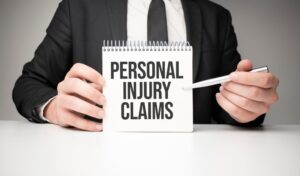When another person’s negligence injures you, you may know you can seek compensation for your medical bills. However, your recoverable damages may also include losses for emotional distress and pain and suffering. A personal injury attorney can help you identify all your potential damages and fight to secure fair compensation.
What Is A Personal Injury Claim?
A personal injury claim is a legal action filed by an individual (the plaintiff) who has suffered physical, emotional, or financial harm due to another party’s negligence, recklessness, or intentional actions. These claims seek compensation for medical expenses, lost earnings, pain and suffering, and emotional distress.
Personal injury claims typically arise from car accidents, slips and falls, medical malpractice, defective products, or workplace injuries. The legal process involves proving that the defendant owed a duty of care, breached that duty, and directly caused the plaintiff’s injuries.
To pursue a claim, the plaintiff must file within the state’s statute of limitations, generally two years from the date of the injury. Exceptions such as a one-year limit for claims against government entities may apply. Evidence, including medical records, witness statements, and professional testimony is vital in establishing liability and determining the amount of damages.
Compensation in a personal injury claim may include economic damages (like medical costs and lost income) and non-economic damages (like pain and suffering). Part of non-economic damages is emotional distress from physical injuries.
Hiring an experienced personal injury attorney can strengthen a claim. Lawyers handle complex legal procedures, negotiate with insurance companies, and, if necessary, represent clients in court. Most work on a contingency fee basis, meaning there are no upfront costs for the plaintiff.
What Types Of Accidents Lead To Personal Injury Claims?
 Personal injury claims arise from a wide range of accidents caused by another party’s negligence, recklessness, or intentional actions. These claims seek compensation for physical injuries, emotional distress, and financial losses, such as medical bills and lost income. The types of accidents leading to personal injury claims are diverse, reflecting common scenarios where individuals suffer harm due to someone else’s failure to exercise reasonable care.
Personal injury claims arise from a wide range of accidents caused by another party’s negligence, recklessness, or intentional actions. These claims seek compensation for physical injuries, emotional distress, and financial losses, such as medical bills and lost income. The types of accidents leading to personal injury claims are diverse, reflecting common scenarios where individuals suffer harm due to someone else’s failure to exercise reasonable care.
Understanding these categories helps victims identify whether they have a valid claim under the state law, where the statute of limitations for most personal injury cases is two to three years from the date of the incident. Each state varies in this strict timeline.
Car Accidents
In most states, car accidents are generally among the most common sources of personal injury claims. These include collisions caused by distracted driving, speeding, drunk driving, or failure to follow traffic laws. Victims may suffer whiplash, fractures, or traumatic brain injuries, leading to claims for medical costs, pain and suffering, and lost income. A fault system, such as is followed in California, for example, can reduce compensation when the plaintiff shares responsibility, for example, by not wearing a seatbelt during the accident.
Slip and Fall Accidents
Slip and fall accidents, also known as premises liability cases, occur when property owners fail to maintain safe conditions, resulting in injuries. Examples include wet floors in stores, uneven sidewalks, or poorly lit staircases. Victims can claim damages for injuries such as broken bones or sprains, provided they can prove that the property owner was aware of or should have been aware of the hazard. These claims often involve emotional distress damages if the incident causes significant psychological harm.
Medical Malpractice
Medical malpractice claims arise when healthcare professionals, such as doctors or nurses, provide substandard care, resulting in injury or worsening of a patient’s condition. Examples include surgical errors, misdiagnoses, or medication mistakes.
Product Liability
Product liability claims arise from defective products, including faulty car parts, dangerous drugs, or unsafe consumer goods. Some states apply strict liability, meaning manufacturers can be held responsible without proving negligence if the product was defective and caused harm.
Other common accident types include workplace injuries, dog bites, and assault or battery for intentional acts causing injury. An experienced personal injury attorney can evaluate the accident, gather evidence, and pursue compensation under legal framework.
What Compensation Is Available in a Personal Injury Claim?
Personal injury claims, compensation for “damages,” is awarded to help the injured party recover from losses caused by another’s negligence or intentional actions.
We categorize these damages into economic, non-economic, and, in rare cases, punitive damages. The type and amount of compensation depend on the specific details of the case, including the severity of the injury, its impact on the victim’s life, and the degree of fault. The legal system aims to make the injured party “whole” by addressing tangible and intangible losses.
Economic Damages
Economic damages cover quantifiable financial losses. These include medical expenses (past and future treatments, surgeries, or therapy), lost earnings from time off work, and loss of earning capacity if the injury affects future employment. Other economic damages may include property damage or costs for rehabilitation and assistive devices. In most cases, the law allows plaintiffs to recover these losses fully, supported by evidence like bills, pay stubs, or professional testimony.
Non-Economic Damages
Non-economic damages compensate for intangible losses that don’t have a clear dollar value. These include pain and suffering, emotional distress, loss of enjoyment of life, and loss of companionship or consortium (for family members affected by the injury).
States like California do not cap non-economic damages in most personal injury cases.
Punitive Damages
Punitive damages are rare and awarded only when the defendant’s conduct is deemed malicious, fraudulent, or grossly reckless. These damages punish the wrongdoer and deter similar behavior, rather than directly compensating the victim.
Courts carefully scrutinize punitive damage awards to ensure they are proportionate. They are often guided by U.S. Supreme Court precedent suggesting a ratio of punitive to compensatory damages not exceeding 9:1.
What Are Emotional Distress Damages In A Personal Injury Claim?
In a personal injury claim, emotional distress damages compensate plaintiffs for the psychological and emotional harm caused by another party’s negligence, recklessness, or intentional actions. These damages address intangible losses, such as anxiety, depression, fear, insomnia, or post-traumatic stress disorder (PTSD), that significantly impact the plaintiff’s quality of life.
Unlike economic damages, which cover measurable costs like medical bills, emotional distress damages are subjective and more complex to quantify, requiring compelling evidence like medical records, psychological evaluations, or testimony from mental health professionals to substantiate the claim.
Personal injury claims pursue emotional distress damages mainly through negligent infliction of emotional distress (NIED) and intentional infliction of emotional distress (IIED). For NIED, the plaintiff must show that the defendant’s careless actions caused serious emotional distress, often tied to physical injury or witnessing a traumatic event, such as a loved one’s injury.
Some states cap emotional distress compensation and some, such as California, do not. When the state does not cap this type of damage in standard personal injury cases, it allows juries to award amounts based on the circumstances of the case.
However, in medical malpractice cases, non-economic damages, including emotional distress, are capped at $350,000 for injuries or $500,000 for wrongful death, adjusted annually for inflation under the Medical Injury Compensation Reform Act (MICRA). Evidence like therapy records, medication prescriptions, or personal journals can strengthen a claim for emotional distress damages.
Proving emotional distress requires demonstrating a direct link between the defendant’s actions and the plaintiff’s psychological harm. Courts may scrutinize claims to ensure genuine and substantial distress, not fleeting or minor. An experienced personal injury attorney can help by working with mental health professionals and gathering evidence to build a strong case.
What Is My Personal Injury Claim Worth?
Determining the value of a personal injury claim depends on several factors specific to the case, as no two claims are identical. The worth of a claim hinges on the extent of the plaintiff’s injuries, the impact on their life, and the degree of the defendant’s liability.
Compensation typically includes economic, non-economic, and, in rare cases, punitive damages. Fault-sharing rules and damage caps also influence the final amount. An experienced personal injury attorney can assess these factors to estimate a claim’s value.
Economic damages cover tangible financial losses. These include past and future medical expenses, lost income from missed work, and reduced earning capacity if the injury affects future employment.
Other costs, like property damage or rehabilitation expenses, may also be included. For example, if a car accident victim incurs $50,000 in medical bills and loses $20,000 in earnings, these amounts serve as the basis for economic damages. Lawyers use receipts, pay stubs, and professional testimony to quantify these losses accurately.
Non-economic damages compensate for intangible harms, such as pain and suffering, emotional distress, or loss of enjoyment of life. These are more challenging to calculate, as they rely on subjective factors such as the severity of the injury and its emotional impact.
An attorney evaluates these elements by reviewing medical records, consulting professionals, and assessing case law. Insurance companies often offer low initial settlements, making legal representation invaluable for negotiating or litigating for fair compensation. Factors like the defendant’s ability to pay and the strength of evidence also impact the outcome. Consult a personal injury lawyer early, document and pursue all damages effectively, maximizing the claim’s value.
How Can A Personal Injury Lawyer Help Me?
 A personal injury lawyer can be an invaluable ally in managing the complex legal process to secure fair compensation for injuries, emotional distress, and financial losses caused by another party’s negligence or intentional actions.
A personal injury lawyer can be an invaluable ally in managing the complex legal process to secure fair compensation for injuries, emotional distress, and financial losses caused by another party’s negligence or intentional actions.
Case Evaluation and Strategy
A personal injury lawyer begins by assessing the merits of your case, reviewing evidence like medical records, police reports, and witness statements. They determine the strength of your claim, identify liable parties, and estimate potential compensation, including economic and non-economic damages.
Evidence Gathering and Professional Collaboration
Proving liability and damages requires robust evidence. A lawyer collects critical documentation, such as accident reports, photos, and medical diagnoses, and may hire professionals like accident reconstructionists or psychologists to substantiate claims, especially for emotional distress.
Negotiation with Insurance Companies
Insurance companies often offer low settlements to minimize payouts. A skilled lawyer negotiates aggressively on your behalf, countering tactics like blaming you for the accident or downplaying your injuries. They ensure all damages, including future medical costs and emotional trauma, are accounted for. Most personal injury lawyers work on a contingency fee basis, meaning no upfront costs—you pay only if they recover compensation.
Maximize Compensation
Your personal injury attorney will ensure you receive the most compensation for your economic and non-economic damages, including emotional distress. Many injury victims underestimate their injuries and losses, and many may not even know that they are entitled to money for their emotional suffering. Your attorney will ensure you receive all the money you are entitled to for a full recovery.
Legal Compliance and Representation
The statute of limitations for most personal injury claims is two to three years, and varies by state. This strict deadline requires timely action. A lawyer meets deadlines, files paperwork correctly, and ensures your case complies with state laws. If they don’t reach a fair settlement, they represent you in court and present a compelling case to a judge or jury. By handling these complexities, a personal injury lawyer increases your chances of obtaining the compensation you deserve while reducing stress during a challenging time.
FAQs Regarding Emotional Distress
What evidence helps prove emotional distress?
To prove emotional distress, you can use several types of evidence. Medical records from therapists, psychologists, or psychiatrists that diagnose conditions like anxiety, depression, or PTSD are powerful.
Your own journal detailing your feelings, sleep loss, and anxiety can also serve as evidence. Testimony from family, friends, or coworkers who can describe the changes in your emotional state since the incident also helps substantiate your claim.
How do courts and insurance companies put a dollar value on emotional distress?
There is no simple formula. Insurance companies sometimes use a multiplier method, where they multiply your economic damages (like medical bills) by a number based on the severity of your injuries and suffering.
In court, juries listen to testimony about how the emotional trauma has impacted your daily life, relationships, and ability to work or enjoy activities. They then use their judgment to award a fair and reasonable amount based on the evidence presented.
Does a pre-existing mental health condition affect my emotional distress claim?
It can, but it does not prevent you from recovering damages. The defendant is responsible for aggravating a pre-existing condition. For example, if you had managed anxiety before the accident but now suffer from debilitating panic attacks, you can claim damages for that worsening of your condition.
Full disclosure of your medical history to your attorney is crucial to properly frame this aspect of your claim.
Contact A Personal Injury Lawyer Now
Have you suffered injuries or emotional distress due to someone else’s negligence? You deserve justice and fair compensation. Experienced California personal injury lawyer are ready to fight for you in your community.
Whether it’s a car accident, a slip and fall, or a workplace injury, we understand the physical pain and emotional toll you’re enduring. Don’t let medical bills, lost earnings, or suffering overwhelm you. Take action today. Your attorney will work tirelessly to secure the compensation you deserve, with no upfront costs.
From the initial consultation through every step of your case, we stand by your side, handling the legal complexities so you can focus on healing and moving forward confidently. Reach out now to protect your rights and get the support you need.
